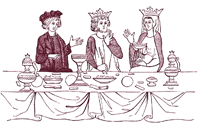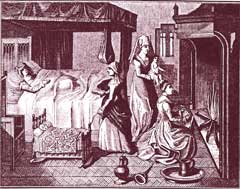Medieval Castle Life
Life in the Medieval castle of the first period of Feudalism was rough and laborious, characterized by monotony and loneliness. It was much affected by the vicissitudes of those insecure times. The Medieval castles owners had little time to devote to the pleasures of private life. They had not only to be continually under arms for the quarrels of the King and the great chiefs; more then that, the French for example, had also to oppose the Normans on one side, and the Saracens on the other, who, being masters of the Spanish peninsula, spread like the rising tide in the southern counties of Languedoc and Provence in France.

Knight Leaving The Castle
In such a turbulent period, it often happened that the owner of the fief had to leave his castle. This led to major changes in the way the castle life was organized. The lord's wife remained there in a totally different position from that which women generally held. She remained as mistress, representing her husband, and was charged with the defense and honor of the feudal domain. This high position in the centre of the Medieval domestic life, often gave to women an opportunity of displaying dignity, courage, virtue, and intelligence, which would otherwise remained hidden. No doubt, this contributed greatly to their moral development, and to the general improvement in the condition of women .
Whatever opinion may be formed of chivalry, it is impossible to deny the influence which this institution exercised on private life in the Middle Ages. It considerably modified the daily life in castles, by bringing the stronger sex to respect and defend the weaker.
A deep feeling of veneration for woman, inspired by Christianity, and, above all, by the worship of the Virgin Mary, ran throughout the songs of the troubadours, and produced a sort of sentiment of reverence for the gentle sex.
By the end of the 12th Century arts, sciences, and letters start again to add their charm to the leisure of Medieval castle life. The castles were naturally the first to be affected by this poetical and intellectual regeneration. Many of the knights composed poems attesting their high literary culture.
It was the epoch of troubadours, professional poets and actors, who went from country to country, and from castle to castle, relating legends and historical poems. These minstrels were always accompanied by jugglers and instrumentalists, forming a traveling troop, with the mission to amuse and instruct their feudal hosts. These troops were also acting small comedies, taken from incidents of the time. Sometimes, the instrumentalists formed an orchestra, and dancing commenced. Dancing at this epoch consisted of a number of persons forming large circles, and turning to the time of the music or the rhythm of the song.

A Medieval Baron Dining
Down to the reign of St. Louis of France, life in the Medieval castle did not lack grandeur, however the furniture had preserved a character of primitive simplicity. The stone remained uncovered in most of the halls, or it was whitened with mortar and ornamented with colored molded roses and leaves. Against the wall, and also against the pillars supporting the arches, arms and armors of all sorts were hung, interspersed with banners and emblazoned standards.
In the great Medieval hall, which was at the centre of castle life, there was the long massive oak dinning table, with benches and stools of the same wood. At the end of the table there was a large armchair, overhung with a canopy of golden or silken stuff, which was occupied by the owner of the castle, and only relinquished by him in favor of his superior or sovereign.
Often the walls of the hall were hung with tapestry representing heroes of ancient history, or events in the romance of chivalry. The floor was generally paved with hard stone, or covered with enameled tiles. It was carefully strewn with scented herbs in summer and straw in winter. Only much later this somehow troublesome system was replaced by mats and carpets.
Meals time in a Medieval castleThe usual time of dining was ten or eleven. The supper was at five in the afternoon. It was a popular saying in the Middle Ages that to live to the age of 99 years old, you have to wake up at five, dine at nine, have supper at five and go to bed at nine!

A New Born in the Castle
The bedrooms were generally at the top of the towers, and had a bed, with or without curtains, a box in which clothes were kept, and which also served as a seat, and a chair for prayers, which sometimes contained the prayer and other books of devotion. The rooms were only lighted by a small window or loophole, closed with a square of oiled paper or of thin horn.
Amongst the customs which contributed most to the softening and elegance of the feudal class, was that of sending their youth of both sexes into the service of the sovereign. For some years they were valets, pages, squires, and maids of honor.
During the Late Middle Ages comfort and luxury became constant characteristics of castle life. The fact was facilitated by the transition from the fortress type to a comfort oriented castle. The number of rooms increased in a spectacular manner, and the various conveniences added to the simplicity of previous times greatly improved the daily lives of the castle people.
Beside the halls and bedrooms, now there were wine-cellars, bake houses, fruiteries, salt-stores, fur-rooms, porters' lodges, tapestry rooms, linen-rooms, laundry. Ornamental furniture flourished, and the rooms were hung with more expensive materials like cloth of gold, bordered with vermilion velvet embroidered with roses, making the life in a Medieval castle more refined and sophisticated.
